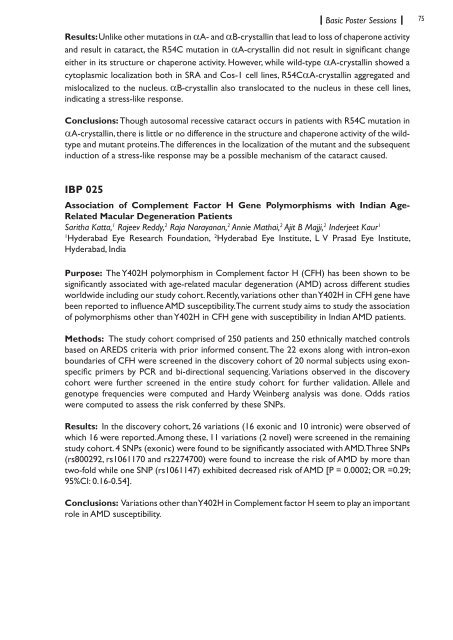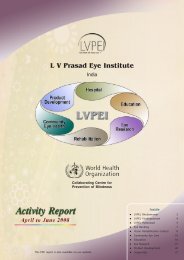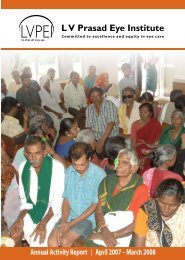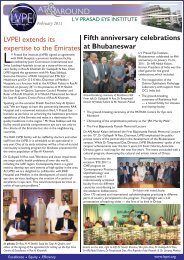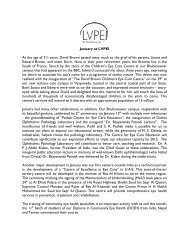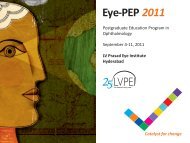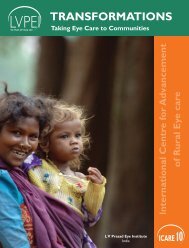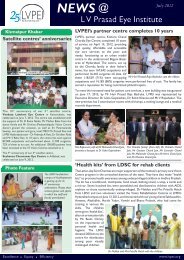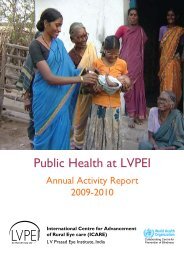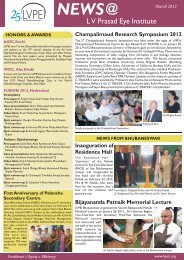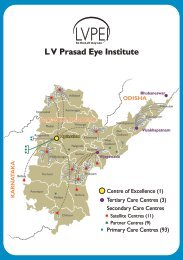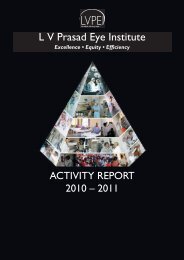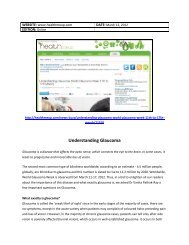IERG Abstracrt Book.indd - LV Prasad Eye Institute
IERG Abstracrt Book.indd - LV Prasad Eye Institute
IERG Abstracrt Book.indd - LV Prasad Eye Institute
You also want an ePaper? Increase the reach of your titles
YUMPU automatically turns print PDFs into web optimized ePapers that Google loves.
Basic Poster Sessions75Results: Unlike other mutations in aA- and aB-crystallin that lead to loss of chaperone activityand result in cataract, the R54C mutation in aA-crystallin did not result in significant changeeither in its structure or chaperone activity. However, while wild-type aA-crystallin showed acytoplasmic localization both in SRA and Cos-1 cell lines, R54CaA-crystallin aggregated andmislocalized to the nucleus. aB-crystallin also translocated to the nucleus in these cell lines,indicating a stress-like response.Conclusions: Though autosomal recessive cataract occurs in patients with R54C mutation inaA-crystallin, there is little or no difference in the structure and chaperone activity of the wildtypeand mutant proteins. The differences in the localization of the mutant and the subsequentinduction of a stress-like response may be a possible mechanism of the cataract caused.IBP 025Association of Complement Factor H Gene Polymorphisms with Indian Age-Related Macular Degeneration PatientsSaritha Katta, 1 Rajeev Reddy, 2 Raja Narayanan, 2 Annie Mathai, 2 Ajit B Majji, 2 Inderjeet Kaur 11Hyderabad <strong>Eye</strong> Research Foundation, 2 Hyderabad <strong>Eye</strong> <strong>Institute</strong>, L V <strong>Prasad</strong> <strong>Eye</strong> <strong>Institute</strong>,Hyderabad, IndiaPurpose: The Y402H polymorphism in Complement factor H (CFH) has been shown to besignificantly associated with age-related macular degeneration (AMD) across different studiesworldwide including our study cohort. Recently, variations other than Y402H in CFH gene havebeen reported to influence AMD susceptibility. The current study aims to study the associationof polymorphisms other than Y402H in CFH gene with susceptibility in Indian AMD patients.Methods: The study cohort comprised of 250 patients and 250 ethnically matched controlsbased on AREDS criteria with prior informed consent. The 22 exons along with intron-exonboundaries of CFH were screened in the discovery cohort of 20 normal subjects using exonspecificprimers by PCR and bi-directional sequencing. Variations observed in the discoverycohort were further screened in the entire study cohort for further validation. Allele andgenotype frequencies were computed and Hardy Weinberg analysis was done. Odds ratioswere computed to assess the risk conferred by these SNPs.Results: In the discovery cohort, 26 variations (16 exonic and 10 intronic) were observed ofwhich 16 were reported. Among these, 11 variations (2 novel) were screened in the remainingstudy cohort. 4 SNPs (exonic) were found to be significantly associated with AMD. Three SNPs(rs800292, rs1061170 and rs2274700) were found to increase the risk of AMD by more thantwo-fold while one SNP (rs1061147) exhibited decreased risk of AMD [P = 0.0002; OR =0.29;95%CI: 0.16-0.54].Conclusions: Variations other than Y402H in Complement factor H seem to play an importantrole in AMD susceptibility.


